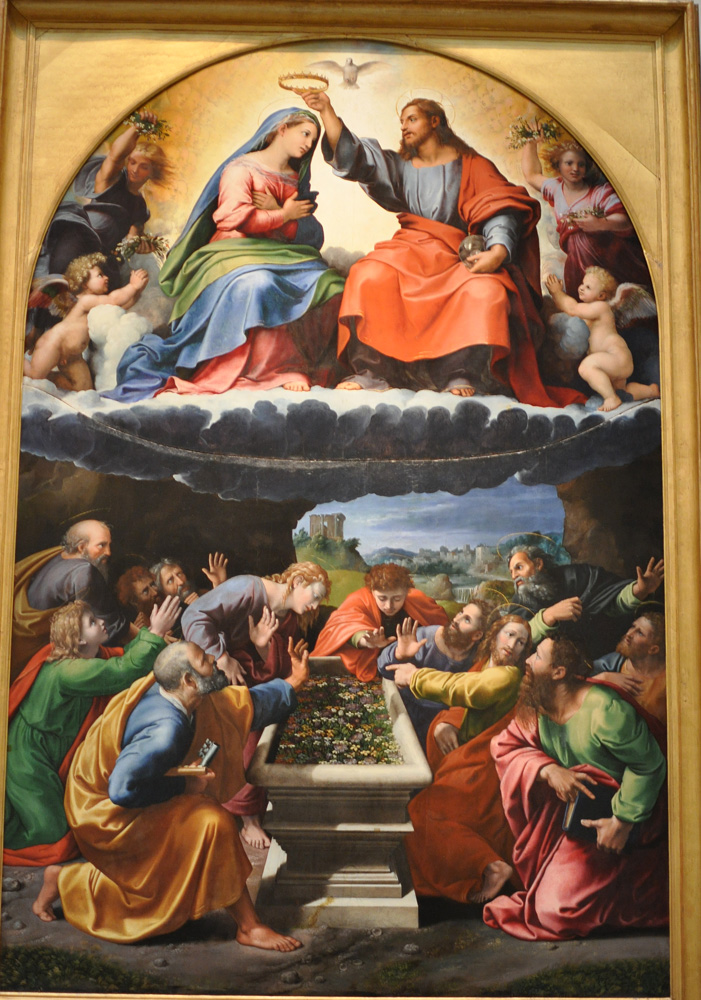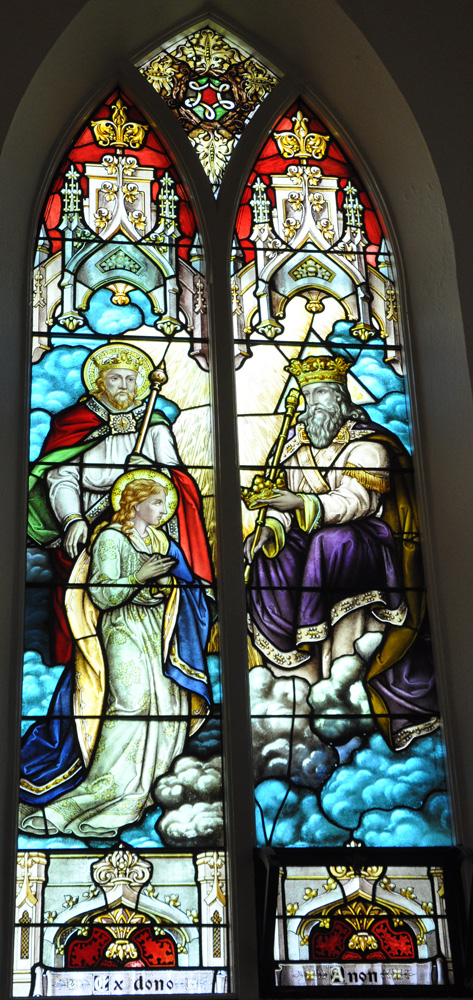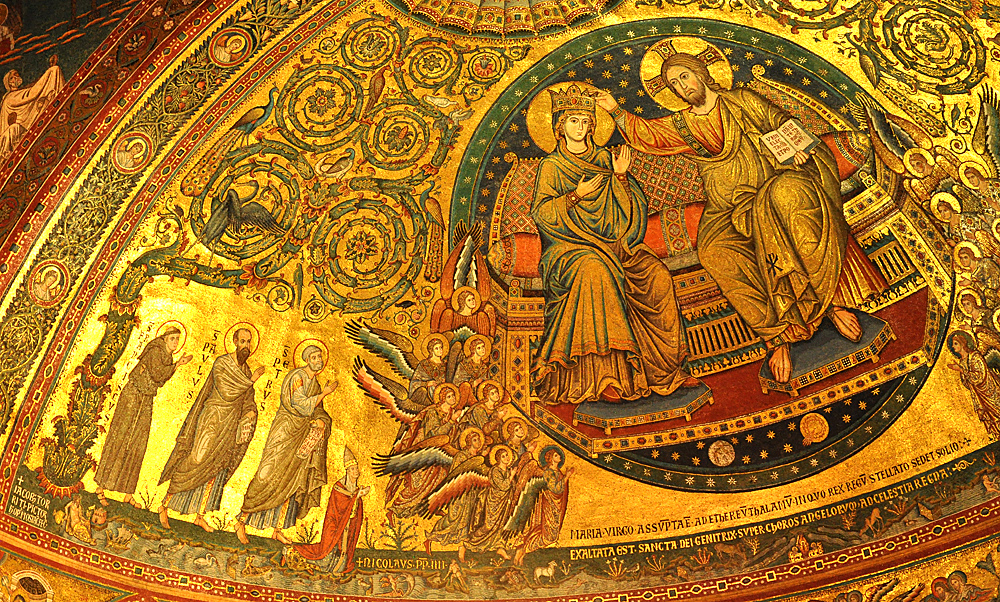The earliest visual reference to this trope that I have seen is a Catalan apse fresco of the first half of the 12th-century. A band beneath the large image of Christ in glory contains standing portraits of Mary and the apostles, each with an attribute. Mary's attribute is a crown, which she holds in her left hand.
We see a full development of the trope in a tympanum at Senlis from about 1170, where Christ and Mary share a throne, both of them wearing crowns. This composition is repeated almost exactly in a tympanum at Chartres (1194-1260) and less exactly in the apse mosaic at Santa Maria in Trastevere.
These works would more properly be called "Enthronements" rather than "Coronations," because in them Mary already has her crown. Indeed, there is still no mention of a coronation in the Golden Legend's extensive account of Mary's reception into Heaven in 1260. But true Coronation images begin to show up in the 13th century and eventually become the standard. One the early example is the tympanum of the Portal of the Virgin (1210s-1220s) at Notre Dame de Paris, in which an angel reaches down from above the Virgin to place the crown on her head. The angel also does the crowning in an ivory from about 50 years later, but by the end of the century the typical Coronation shows Christ himself placing the crown on Mary's head as the two sit enthroned and flanked by angels. This is the pattern in the mosaic at the top of this page and in most of the ensuing centuries.
A less common pattern has Mary crowned by the Trinity. In some images she is seated between the Son and the Father, who together place the crown on her head while the Holy Spirit hovers just above (example). One example, a Mexican nun's badge, combines the Coronation by the Trinity with the iconography of the Immaculate Conception. A Spanish relief from 1200 appears to include an antecedent of this type. In an unusual Spanish example from the 18th century, the Trinity is pictured as three identical men, one of whom has just placed the crown on Mary's head. In other variants the Father alone crowns Mary, who kneels before him with her arms crossed over her breast, as in the second picture at right. In this example the Father expresses a paternal blessing by standing behind Christ and Mary with his hands on their shoulders.
THE HAND GESTURES
In the earlier examples cited on this page it is common for Mary to express humility by holding her hands forward, palms out. This usage fades away in the 15th century, replaced by the "praying hands" gesture or the crossing of the arms over her breast, which are both about equal in frequency.
Prepared in 2016 by Richard Stracke, Emeritus Professor of English, Augusta University.
HOME PAGE
The apse mosaic at Santa Maria Maggiore (circa 1290) typifies the most common way of picturing the Coronation of the Virgin. See the description page for an analysis of its relation to the Offices for the Feast of the Assumption.
OTHER IMAGES

Raphael put the Coronation scene above one in which the Apostles find Mary's sepulcher empty except for a profusion of flowers. See the description page.

This 19th-century window follows 15th-century models such as Botticelli's Coronation of the Virgin (1490-92): the Father crowns Mary while she kneels before him with arms crossed over her breast. In this type she may be presented by the Son, as here, or by an angel, as in 15th-century miniatures by Maitre François and Jean Poyet (Wieck, 7, 38). See the description page.
MORE IMAGES- 1330-35, Cologne: Manuscript illumination, Mary and Christ enthroned in Heaven with the angels and the saints.
- 1344: Guariento di Arpo's Coronation of the Virgin altarpiece.
- 1350-90: Cesare Nebbia's mosaic for the façade of Orvieto Cathedral
- 1390s: Cenni di Francesco's altarpiece, The Coronation of the Virgin with Saints.
- 14th or 15th century: Illustration in a gradual
- Early 15th century: Pseudo Ambrogio di Baldese's Coronation of the Virgin
- 15th century: A combined Assumption/Coronation with identical images of the Father and Son.
- 15th century: l'Alunno's Altarpiece of the Coronation of the Virgin.
- 1414: Lorenzo Monaco's Coronation of the Virgin with Saints.
- 1420: The Holy Spirit hovers above while Christ crowns the Virgin in this painting by Gentile da Fabriano.
- Late 15th century: Niccolò di Giovanni's relief at Trogir Cathedral, Croatia.
- 1502: In Tullio Lombardo's relief the coronation takes place in an earthly setting among the Apostles while the Father looks down from above and the Holy Spirit descends on the group.
- 1502-1504: Raphael's Oddi Altarpiece
- 1547-51: At the summit of Roque de Balduque;s Cáceres Altarpiece.
- After 1680: Antonio Zanchi, The Coronation of the Virgin on the ceiling of Santa Maria del Giglio, Venice.
- Early 20th century: in Gaudí's Nativity Portal at the Sagrada Familia in Barcelona
DATES
- There is no Feast of the Coronation. The Assumption ("Dormition" in the East) is celebrated on August 15.
ALSO SEE
RELEVANT MEDIEVAL TEXTS
- Golden Legend #119 (Assumption of the Virgin): html or pdf
- "In Assumptione B. Mariae Virginis," in Breviarium Romanum, 991-95.
- "In Assumptione Beatae Mariae Virginis," in Missale Romanum, 601-602
- "Feast of the Assumption," in Toal, IV, 412-45
- Daley, On the Dormition of Mary: Early Patristic Homilies
NOTE
1 For the Catalan fresco, see Camps y Montserrat, 18-19 and 21. See Toal for Andrew of Crete (IV, 104-108) and John of Damascus (IV, 432). The 9th-century work is quoted and erroneously attributed to St. Jerome in the Golden Legend, chapter 119 (Ryan II, 64). The antiphon quoted is in the Office of Lauds for Assumption Day as established after the Council of Trent. See Breviarium Romanum, 995 (my translation). It does not appear in the modern breviary's Office of Lauds, but there the last of the Intercessions is "Lord of heaven and earth, you crowned Mary and set her at your right hand as queen, make us worthy to share this glory" (Christian Prayer, 1228).
